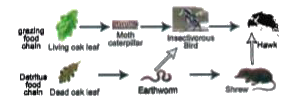What is the difference between a grazing food chain and a detritus food chain?
To understand the difference between a grazing food chain and a detritus food chain, we can break it down into several key points:
1. Definition of Grazing Food Chain:
- A grazing food chain is a type of food chain where the energy flow starts from producers (green plants) and moves up to herbivores and then to carnivores.
- In this chain, the primary producers convert sunlight into energy through photosynthesis, which is then consumed by herbivores (primary consumers) and subsequently by carnivores (secondary and tertiary consumers).
2. Definition of Detritus Food Chain:
- A detritus food chain, on the other hand, begins with dead organic matter or detritus, which includes decomposing plant and animal remains.
- The energy flow in this chain starts from decomposers (like fungi and bacteria) that break down the dead organic material, which is then consumed by detritivores (organisms that feed on detritus, such as earthworms and certain insects).
3. Main Source of Energy:
- In a grazing food chain, the main source of energy is the producers (green plants).
- In a detritus food chain, the main source of energy is the dead remains of organisms or decayed matter.
4. Organisms Involved:
- Grazing food chains typically involve a sequence of living organisms, starting with plants, followed by herbivores, and then carnivores.
- Detritus food chains involve decomposers and detritivores that feed on dead organic matter, highlighting the role of decay in the ecosystem.
5. Ecological Role:
- Grazing food chains are crucial for energy transfer in ecosystems that are rich in living plant life.
- Detritus food chains play a vital role in nutrient recycling and the decomposition process, ensuring that nutrients are returned to the soil for use by plants.
Summary of Differences:
- Energy Source: Grazing food chain (producers) vs. Detritus food chain (dead organic matter).
- Organisms: Grazing food chain (plants, herbivores, carnivores) vs. Detritus food chain (decomposers, detritivores).
- Ecological Function: Grazing food chain focuses on energy transfer from living organisms, while the detritus food chain emphasizes decomposition and nutrient recycling.
- A grazing food chain is a type of food chain where the energy flow starts from producers (green plants) and moves up to herbivores and then to carnivores.
- In this chain, the primary producers convert sunlight into energy through photosynthesis, which is then consumed by herbivores (primary consumers) and subsequently by carnivores (secondary and tertiary consumers).
- A detritus food chain, on the other hand, begins with dead organic matter or detritus, which includes decomposing plant and animal remains.
- The energy flow in this chain starts from decomposers (like fungi and bacteria) that break down the dead organic material, which is then consumed by detritivores (organisms that feed on detritus, such as earthworms and certain insects).
- In a grazing food chain, the main source of energy is the producers (green plants).
- In a detritus food chain, the main source of energy is the dead remains of organisms or decayed matter.
- Grazing food chains typically involve a sequence of living organisms, starting with plants, followed by herbivores, and then carnivores.
- Detritus food chains involve decomposers and detritivores that feed on dead organic matter, highlighting the role of decay in the ecosystem.
- Grazing food chains are crucial for energy transfer in ecosystems that are rich in living plant life.
- Detritus food chains play a vital role in nutrient recycling and the decomposition process, ensuring that nutrients are returned to the soil for use by plants.
- Energy Source: Grazing food chain (producers) vs. Detritus food chain (dead organic matter).
- Organisms: Grazing food chain (plants, herbivores, carnivores) vs. Detritus food chain (decomposers, detritivores).
- Ecological Function: Grazing food chain focuses on energy transfer from living organisms, while the detritus food chain emphasizes decomposition and nutrient recycling.
Topper's Solved these Questions
- ECOSYSTEMSBOOK - ICSECHAPTER - ECOSYSTEMSEXERCISE - PRACTICE QUESTINS (LONG ANSWER TYPE QUESTIONS)
13 Videos
- ECOSYSTEMSBOOK - ICSECHAPTER - ECOSYSTEMSEXERCISE - PREVIOUS YEARS.S BOARD PAPER QUESTIONS (VERY SHORT ANSWER TYPE QUESTIONS)
5 Videos
- ECOSYSTEMSBOOK - ICSECHAPTER - ECOSYSTEMSEXERCISE - PRACTICE QUESTINS (SHORT ANSWER TYPE- I QUESTIONS)
9 Videos
- BIOTECHNOLOGY AND ITS APPLICATIONS BOOK - ICSECHAPTER - BIOTECHNOLOGY AND ITS APPLICATIONS EXERCISE - COMPETITION CORNER (OBJECTIVE TYPE QUESTIONS (ASSERTION AND REASON TYPE QUESTIONS))
9 Videos
- ENVIRONMENTAL ISSUESBOOK - ICSECHAPTER - ENVIRONMENTAL ISSUESEXERCISE - COMPETITION CORNER (ASSERTION AND REASON TYPE QUESTIONS (FOR AIIMS ASPIRANTS))
9 Videos
Similar Questions
Given figure represents food chains of a deciduous woodland linked together to form a food web.

Which of the following constitute first trophic level of the grazing food chain and the detritus food chain respectively ?
View SolutionWhat is a food chain?
View SolutionState the difference between the first trophic levels of detritus food chain and grazing food chain.
View SolutionState the difference between the first trophic levels of detritus food chain and grazing food chain.
View SolutionGive two differences between food chain food web.
View SolutionThe food chain ends with
View SolutionOrganisms associated with detritus food chain are
View SolutionPrimary consumers in detritus food chain are
View SolutionName an omnivore which occurs in both grazing food chain and the decomposer food chain.
View SolutionA food chain starts with
View Solution
